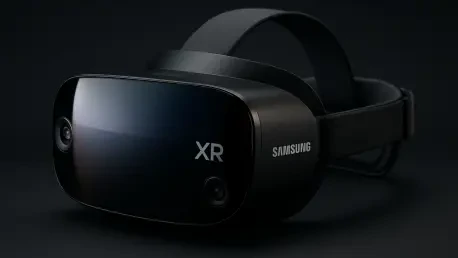In an era where virtual and augmented reality are reshaping how people interact with digital content, the demand for cutting-edge XR devices has never been higher, with market projections estimating over 50 million units sold globally by 2027. Amid this surge, the Samsung Galaxy XR headset, priced at $1,800, emerges as a flagship contender in the extended reality space. This review aims to dissect whether this premium device justifies its cost for XR enthusiasts, professionals, and casual users alike by diving deep into its innovative features and real-world performance.
The evaluation focuses on the headset’s ability to deliver immersive virtual and augmented reality experiences, addressing modern needs for seamless integration in entertainment and productivity. Developed through a powerful collaboration between Samsung, Google, and Qualcomm, the Galaxy XR stands as a pioneering entry in the Android XR ecosystem. This analysis will explore how it sets a benchmark for future devices in this rapidly evolving field.
Overview of Features and Technical Specifications
The Samsung Galaxy XR headset is equipped with state-of-the-art components designed to push the boundaries of XR technology. Its micro-OLED displays offer a staggering near-8K resolution of 3,552 x 3,840 pixels per eye, complemented by adjustable refresh rates of 60Hz, 72Hz, and 90Hz, and a wide field of view spanning 109° horizontally and 100° vertically. An array of cameras and sensors enhances functionality, including video passthrough, 3D content capture, inside-out tracking, eye-tracking, iris recognition for security, and depth sensing for precise spatial awareness.
Design considerations further elevate the user experience with features like an adjustable interpupillary distance ranging from 54 to 70mm, optical inserts for glasses wearers, and a removable light shield for tailored immersion levels. The headset’s hardware is powered by the Snapdragon XR2+ Gen 2 chipset, paired with 16GB of RAM and 256GB of storage, ensuring robust performance. Running on the open Android XR platform, it supports native app compatibility and developer tools such as OpenXR and Unity, fostering a rich ecosystem for content creation.
Unique selling points include integration with Google’s Gemini AI, enabling contextual interactions and the transformation of 2D media into 3D content. This AI capability, combined with advanced connectivity options like Wi-Fi 7 and Bluetooth 5.4, positions the device as a versatile tool for diverse applications. These specifications collectively highlight Samsung’s commitment to delivering a premium XR experience that caters to a wide range of user needs.
Performance Analysis in Real-World Use
When put to the test, the Galaxy XR headset excels in delivering exceptional display clarity, with visuals that are sharp and vibrant, making virtual environments feel strikingly lifelike. Tracking accuracy and responsiveness stand out, particularly in augmented reality scenarios where seamless integration with the real world is critical. Whether navigating complex 3D spaces or interacting with virtual objects, the low-latency 12ms full-color video passthrough ensures a smooth and immersive experience.
Hardware and software integration is another strong suit, with the headset’s six microphones and dual 2-way speakers providing crisp audio that enhances both entertainment and communication. Application performance shines in entertainment contexts, such as theater-like streaming and XR gaming, as well as in productivity tasks like multi-screen setups for work or AI-assisted content creation using tools like Adobe’s Project Pulsar. The Gemini AI adds value by offering real-time assistance, from trip planning to in-game tips, making complex tasks more intuitive.
Comfort during use is a priority, with the headset weighing 545g and a separate 302g battery designed to distribute weight evenly across the forehead and back of the head. While this ergonomic approach reduces strain for short-to-medium sessions, the device is better suited for stationary use rather than extended mobile scenarios. Overall, the balance of performance and design makes it a reliable choice for targeted XR applications.
Strengths and Limitations of the Galaxy XR Headset
Among the standout strengths of the Galaxy XR headset is its unparalleled display quality, setting a new standard for visual fidelity in XR devices. The integration of Gemini AI further enhances its appeal, offering contextual support that transforms routine tasks into interactive experiences, whether in gaming, streaming, or creative projects. Its versatility across use cases—from immersive entertainment to professional workflows—makes it a valuable asset for users seeking a comprehensive XR solution.
Ergonomic design elements, such as customizable fit and weight distribution, ensure comfort during typical usage durations, catering well to users who prioritize short, focused sessions. The ability to adapt immersion levels with removable components also adds a layer of personalization rarely seen in competing devices. These aspects collectively position the headset as a top-tier option for those invested in high-quality XR interactions.
However, limitations exist, notably the battery life of just 2 to 2.5 hours, which hampers its suitability for prolonged outdoor or mobile use. The premium price of $1,800 may deter casual buyers, and the headset’s weight can become noticeable during extended wear. Primarily designed for stationary environments, it may not fully meet the needs of users requiring portability, highlighting areas where future iterations could improve.
Final Assessment and Recommendation
The Galaxy XR headset distinguishes itself through cutting-edge technology, boasting high-resolution visuals that captivate the senses and comprehensive tracking systems that ensure precision in every interaction. Its robust software ecosystem, bolstered by the Android XR platform and AI enhancements, delivers a seamless blend of entertainment and productivity features. This positions the device as a premium offering for those seeking top-tier immersion and utility in their XR experiences.
A balanced verdict reveals that while the headset excels in performance and innovation, its value is best appreciated by XR enthusiasts and professionals willing to invest in quality over cost considerations. The price point and design constraints may not suit every user, particularly those prioritizing portability. Nevertheless, for individuals focused on stationary use and advanced capabilities, this device represents a significant leap forward in the field.
The recommendation leans toward users who value technological advancement and are prepared to navigate the trade-offs of battery life and weight for exceptional performance. Potential buyers should weigh their intended usage against these factors to ensure alignment with personal or professional goals. For the right audience, the Galaxy XR offers an unmatched gateway into the future of extended reality.
Concluding Thoughts and Buyer Guidance
Reflecting on the evaluation, the Samsung Galaxy XR headset carves a notable path in the XR market, establishing a high bar with its innovative blend of hardware and software that captivates users across various applications. Its role as a trailblazer is evident in how it merges superior visuals with AI-driven functionalities, offering a glimpse into the potential of immersive technology.
For prospective buyers, particularly tech enthusiasts, gamers, and content creators, exploring this device means considering its ideal scenarios—stationary setups for deep engagement in virtual worlds or professional tasks. Taking advantage of perks like discounts on accessories or premium content subscriptions in the US adds tangible benefits to the investment.
Moving forward, potential owners are encouraged to assess their usage patterns, balancing budget constraints against the desire for cutting-edge features, and to prioritize environments where the headset’s strengths can shine. Keeping an eye on upcoming developments, such as AI glasses hinted at through Samsung’s partnerships, offers a broader perspective on integrating XR into daily life, ensuring informed decisions in this dynamic tech landscape.









